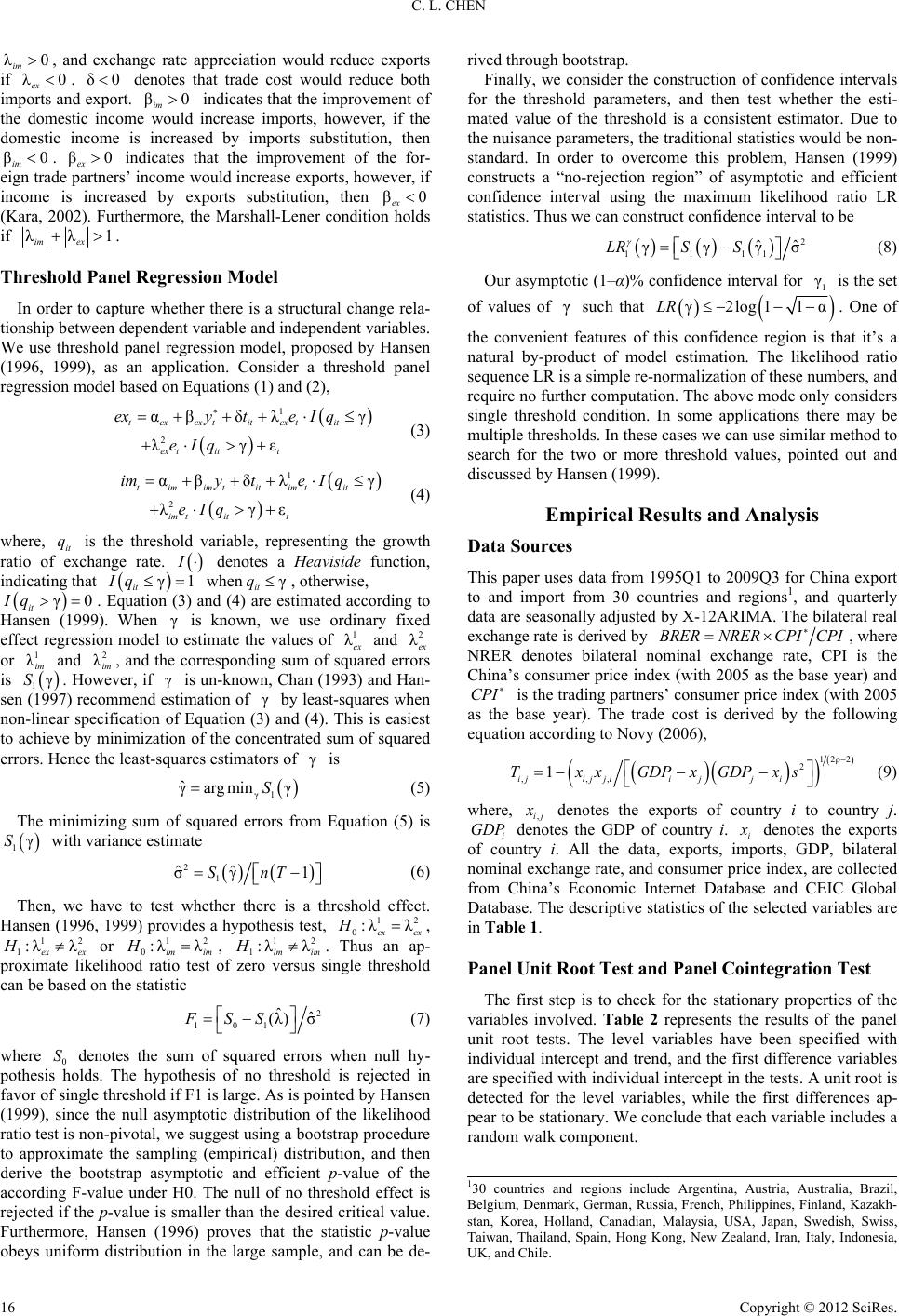
C. L. CHEN
λ0
0δ0
β0
0
β0
im , and exchange rate appreciation would reduce exports
if ex . denotes that trade cost would reduce both
imports and export. im indicates that the improvement of
the domestic income would increase imports, however, if the
domestic income is increased by imports substitution, then
im . indicates that the improvement of the for-
eign trade partners’ income would increase exports, however, if
income is increased by exports substitution, then ex
λ
β0βex
(Kara, 2002). Furthermore, the Marshall-Lener condition holds
if λλ
im ex
1
.
Threshold Panel Regression Model
In order to capture whether there is a structural change rela-
tionship between dependent variable and independent variables.
We use threshold panel regression model, proposed by Hansen
(1996, 1999), as an application. Consider a threshold panel
regression model based on Equations (1) and (2),
2
αβδ 1
λ
λγ
texext it
ex tit
exy t
eIq
ε
ext it
t
eIq
(
3)
2
αβδ 1
λ
λγ
timim tit
im tit
imy t
eIq
ε
im tit
t
eI q
q
(4)
where, it is the threshold variable, representing the growth
ratio of exchange rate.
I
1Iq γq
denotes a Heaviside function,
indicating that it whenit , otherwise,
γ
γIq
1
λim
γS
0
2
λim
it . Equation (3) and (4) are estimated according to
Hansen (1999). When is known, we use ordinary fixed
effect regression model to estimate the values of ex and ex
or and , and the corresponding sum of squared errors
is 1. However, if is un-known, Chan (1993) and Han-
sen (1997) recommend estimation of by least-squares when
non-linear specification of Equation (3) and (4). This is easiest
to achieve by minimization of the concentrated sum of squared
errors. Hence the least-squares estimators of is
γ
γ
1
λ2
λ
γ
γ1
arg min γ
S
1γS
γ
ˆ
γ (
5)
The minimizing sum of squared errors from Equation (5) is
with variance estimate
2
1
ˆˆ
σγ 1SnT
12
:λλH
2
(6)
Then, we have to test whether there is a threshold effect.
Hansen (1996, 1999) provides a hypothesis test, 0exex,
1exex or 0imim, 1imim. Thus an ap-
proximate likelihood ratio test of zero versus single threshold
can be based on the statistic
12
:λλH12
:λλH1
:λλH
2
101
ˆˆ
(λ)σS
S
FS (7)
where 0 denotes the sum of squared errors when null hy-
pothesis holds. The hypothesis of no threshold is rejected in
favor of single threshold if F1 is large. As is pointed by Hansen
(1999), since the null asymptotic distribution of the likelihood
ratio test is non-pivotal, we suggest using a bootstrap procedure
to approximate the sampling (empirical) distribution, and then
derive the bootstrap asymptotic and efficient p-value of the
according F-value under H0. The null of no threshold effect is
rejected if the p-value is smaller than the desired critical value.
Furthermore, Hansen (1996) proves that the statistic p-value
obeys uniform distribution in the large sample, and can be de-
rived through bootstrap.
Finally, we consider the construction of confidence intervals
for the threshold parameters, and then test whether the esti-
mated value of the threshold is a consistent estimator. Due to
the nuisance parameters, the traditional statistics would be non-
standard. In order to overcome this problem, Hansen (1999)
constructs a “no-rejection region” of asymptotic and efficient
confidence interval using the maximum likelihood ratio LR
statistics. Thus we can construct confidence interval to be
2
1111
ˆˆ
γγγσLRS S
1
(8)
Our asymptotic (1–α)% confidence interval for
is the set
γ2log11αLR
such that of values of . One of
the convenient features of this confidence region is that it’s a
natural by-product of model estimation. The likelihood ratio
sequence LR is a simple re-normalization of these numbers, and
require no further computation. The above mode only considers
single threshold condition. In some applications there may be
multiple thresholds. In these cases we can use similar method to
search for the two or more threshold values, pointed out and
discussed by Hansen (1999).
Empirical Results and Analysis
Data Sources
This paper uses data from 1995Q1 to 2009Q3 for China export
to and import from 30 countries and regions1, and quarterly
data are seasonally adjusted by X-12ARIMA. The bilateral real
exchange rate is derived by
RERNRER CPI CPI
CPI
, where
NRER denotes bilateral nominal exchange rate, CPI is the
China’s consumer price index (with 2005 as the base year) and
is the trading partners’ consumer price index (with 2005
as the base year). The trade cost is derived by the following
equation according to Novy (2006),
12ρ2
2
,,,
1
ijij jiijji
TxxGDPxGDPxs
(9)
where, ,ij
denotes the exports of country i to country j.
i denotes the GDP of country i. i
GDP
denotes the exports
of country i. All the data, exports, imports, GDP, bilateral
nominal exchange rate, and consumer price index, are collected
from China’s Economic Internet Database and CEIC Global
Database. The descriptive statistics of the selected variables are
in Table 1.
Panel Unit Root Test and Panel Cointegration Test
The first step is to check for the stationary properties of the
variables involved. Table 2 represents the results of the panel
unit root tests. The level variables have been specified with
individual intercept and trend, and the first difference variables
are specified with individual intercept in the tests. A unit root is
detected for the level variables, while the first differences ap-
pear to be stationary. We conclude that each variable includes a
random walk component.
130 countries and regions include Argentina, Austria, Australia, Brazil,
Belgium, Denmark, German, Russia, French, Philippines, Finland, Kazakh-
stan, Korea, Holland, Canadian, Malaysia, USA, Japan, Swedish, Swiss,
Taiwan, Thailand, Spain, Hong Kong, New Zealand, Iran, Italy, Indonesia,
UK, and Chile.
Copyright © 2012 SciRes.
16